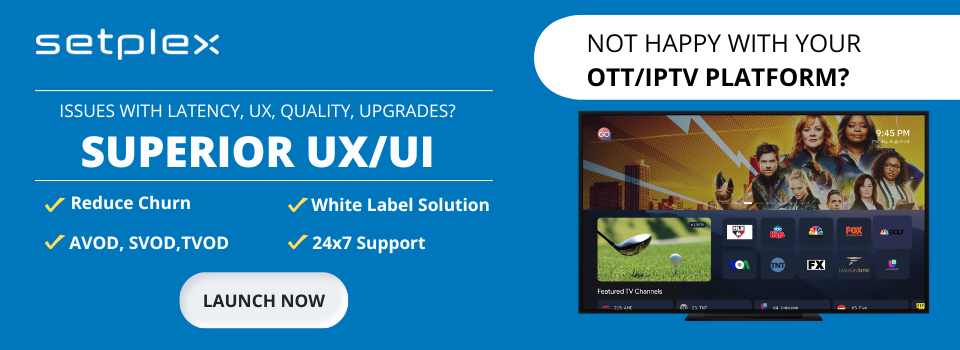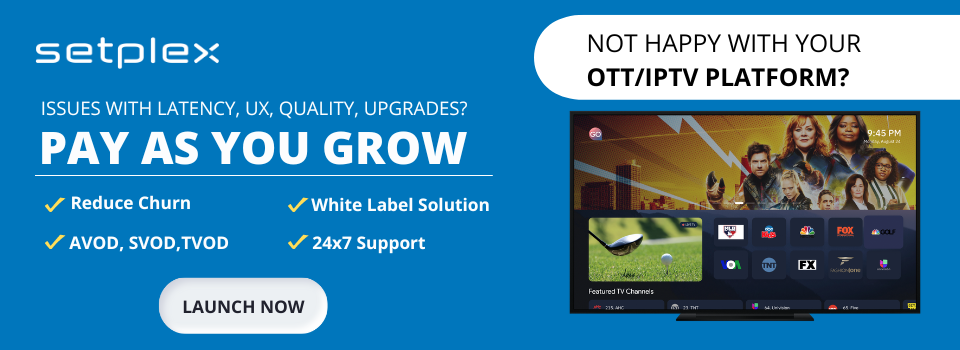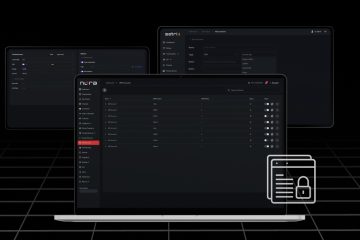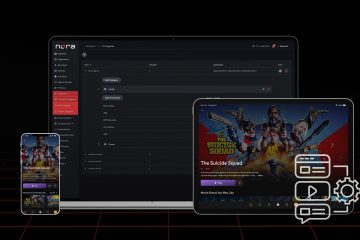Table of Contents
- What is HTTP Video Streaming?
- The Pros & Cons of Using HTTP Streaming
- The Challenge – How to Deliver Optimal User Experience
- Garbage In, Garbage Out
- The Struggle for Quality and Efficiency
- CDN to the Rescue
- Middleware – The Logic Driving the Service
- The Importance of Small Details
- User Interface
- Summary
Today’s plethora of video streaming platforms made consumption of video streaming so pervasive, that we take it for granted. You may stop to think about what really happens under the hood the moment you hit play in your video player. So, let’s take this journey together and try to understand the flows and technologies that empower video streaming, as well as the challenges associated with the delivery of a successful video service.
What is HTTP Video Streaming?
In order to understand a video streaming platform, we should first focus on the core format used for streaming video, since it marks the breadth of functionalities, as well as limitations inherent in today´s video streaming implementations.

In order to manage video delivery over the open Internet (OTT streaming), where there is no way of knowing the bandwidth available for video streaming at any given time, it is necessary to adopt intelligent solutions that provide resiliency.
The ‘HTTP’ in HTTP Streaming indicates that it uses traditional web protocols to transmit the data over a TCP connection.
When a live video is streamed using HTTP Streaming, the video is transcoded and ‘cut’ into small segments for transmission to end user´s devices, be it a mobile or a 55´screen. This makes HTTP Streaming ideal for live streaming in one-to-many streams – any scaling limitation lies essentially on the server hosting the video and is usually overcome using CDNs (Content Distribution Networks).
On the end user´s side, the player on your device recombines the video for playback using instructions contained in a manifest file, which is itself transmitted alongside the video segments.
What makes this delivery mechanism powerful, is that multiple versions (renditions) of the same video – each one at different resolution and bitrate – are generated.
The player on your device has the intelligence that enables it to select the rendition which best suits the screen size of the device you are using to watch the video, as well as the network speed at every moment. And all this is managed dynamically by your player!
The sacrifice you make in the occasional downgrade of video quality (when network conditions become adverse), is more than compensated by the fact that video buffering is minimized. A tradeoff well worth the price in terms of quality of experience.
The same concepts apply also in the case of VoD streaming.
Now let’s delve more in-depth into the reasons that drove HTTP Streaming adoption, its inherent advantages and limitations.
The Pros & Cons of Using HTTP Streaming
- Standard, low cost HTTP server infrastructure vs. expensive proprietary infrastructure used by legacy streaming solutions
- HTTP streaming is not blocked by firewalls and is easily scalable, since it uses the standard HTTP protocol. Legacy streaming solutions had difficulty scaling live-stream delivery since most real-time media protocols required expensive servers that typically only served fewer than 100 simultaneous viewers.
- Two way protocol communication, in order to dynamically select the rendition that best adapts to the fluctuating network conditions. Basically, as the player receives the manifest files – it can request different renditions (video bitrates) to ensure smooth playback, should there be changes in network connectivity.
- Latency: the main downside is that HTTP streaming suffers from about 10-20 seconds of latency (sometimes it can even be longer). Since the video is transcoded into segments, the video must be held up for at least as long as the segment length.

The Challenge – How to Deliver Optimal User Experience
Having looked at the technology empowering today´s video streaming infrastructure, let’s have a look at the challenges video streaming platforms face when delivering a video streaming service.
As is always the case, there is a fancy acronym used to define the end user experience, and in this case, that is QoE (Quality of Experience). QoE is based on the measurement of several distinct parameters of video streaming in order to evaluate the user’s perception of the video service quality, and there are specific formulas used to measure it.
When consuming video, there’s nothing that will make a user click away sooner than bad video quality. This includes long loading times, constant buffering, constant rendition changes and general errors that interrupt playback. As competing video services look to improve their service, user tolerance to poor quality of experience diminishes. QoE has a direct impact on the stickiness of the service and can affect the likelihood of churn.
Whereas in the past just having access to exclusive content was reason enough to endure frustrating playback issues, today, with the number of third-party providers sharing their content among a number of distributors, QoE has become crucial in helping users decide not only which service they should subscribe to, but whether they should continue with that service.
QoE can be a very useful tool for assessing video streaming quality (for SLA compliance purposes, etc.), as well as enable actionable alerts that empower the operator to identify and remedy issues affecting video delivery in a timely manner (in some cases even before the issues are perceived by the end user himself).
Nevertheless, it is important to focus on the bigger picture and take in account other factors which are not directly reflected in QoE formulas themselves, but do affect QoE, and can prove essential in delivering a successful video streaming service. I am referring to details in the system architecture and technology choices that can make the difference between a simply acceptable and a great end user experience. The following paragraphs will cover these factors in detail.
Garbage In, Garbage Out
However advanced and optimized video streaming platforms may be, there is no magic that can recover from poor quality video feeds or poorly optimized video compression and/or transcoding. In this respect, Setplex´s policy of working exclusively with operators who stream properly licensed content, has the side effect of enforcing the use of optimal quality feeds in the input stage of the video streaming platform. This is essential in delivering the best video quality to the end user.
The Struggle for Quality and Efficiency
After feed ingestion, the first stage of video processing is that of Encoding/Transcoding. Codec selection and, more generally, encoder functionalities directly impact the quality of the transcoded stream, as well as encoding efficiency.
In this respect, Setplex’s Setrix IPTV Encoder/Transcoder provides a solid solution, whilst delivering extra functionalities, like Timeshift / Catchup / Ad insertion / Playlist playout, making it a real Media Swiss knife.

CDN to the Rescue
The next stage of the video platform, which is essential for delivering an optimal video streaming service, is the Content Delivery Network (CDN), as proven by the parallel growth in online video consumption and CDN usage witnessed in the last years.
CDNs make it possible to send low-latency video to the end users – thus providing optimal end user experience, while simultaneously reducing costs. CDNs are essential to a high-performance, cost-effective video platform.
Setplex’s video streaming platform comes pre-integrated with one of the top-tier CDNs – Akamai – thus ensuring the best possible end user experience, both for live as well as VoD streaming. Still, if the customer so chooses, it can be deployed using other 3rd party CDNs, thus retaining flexibility to accommodate the specific customer needs.
Middleware – The Logic Driving the Service
The middleware, in the case of a video streaming platform, implements the business logic driving the overall service. The middleware provides the central dashboard, over which configuration of packages, subscribers, devices, payments, analytics, etc. is managed. It is critical that such a platform is resilient, scalable, taking advantage of the latest trends in cloud deployment.
This is where Setplex´s NORA middleware excels, by providing a well tuned and, at the same time, simple to operate platform which has been designed from the ground up to accommodate the business needs of streaming video providers.
Engineered to support both IPTV & OTT services in a single unified platform, Designed from the ground up on a multi tenant based architecture, enabling support of both B2C (business to consumer), as well as B2B (business to business) scenarios, NORA flexibly adapts to the specific operator business requirements.
NORA is cloud native, implemented using the most advanced cloud standards (Kubernetes), and provides a future proof solution on top of which operators can build their video streaming service.
The Importance of Small Details
Sometimes small details can make a big difference in implementing a well thought out and optimized video streaming service.
An example, in the case of Setplex’s middleware solution (NORA), is the possibility of defining device-specific streams, which are optimized for the specific device characteristics (screen size, consumption patterns, etc.)
Thus, in the case of mobile phones, it does not make sense to use the same video stream as the one being used on a 4K 65″ screen, since there is no way of appreciating its visual quality difference on such a small screen. Not to mention the impact that consuming a non-optimized high bit rate stream can have on CDN costs (for service providers) or on hitting data rate caps (for end users).
User Interface
The last critical element of the video delivery chain is the one closest to the end user; the streaming app itself and its UI. A well-designed UI, which is both visually attractive and provides for a fluid interaction, can make a big difference in video consumption and service stickiness.
Bloated and slow, non-optimized and badly designed UIs are not acceptable by end users, no matter how enticing the content may be – especially in today´s reality of a plethora of streaming services competing for user´s attention.
Setplex’s NoraGO app, with its fluid and well-designed UI, ensures an optimal end user experience and facilitates content discovery and consumption.
Summary:
In this article, we focused on highlighting specific technical factors in a video streaming platform that can affect service quality, as perceived by the end user, but also touched on other features that influence the overall success of the service.
All these additional features are included under the umbrella of solution design. This term extends beyond just the technical features, to the business features that shape the platform design.
In an era of the rapid introduction of new services and features in the field of video streaming, a well designed and future proof video streaming platform is one that is flexible enough to adapt to evolving customer expectations, whilst also being proven and well tested over a plethora of deployments and operators of different tiers.
Setplex’s video streaming solution ticks all these marks, making it the ideal solution on top of which to build your video streaming service.



22 Comments
Mae · September 2, 2021 at 7:19 am
You can definitely see your expertise in the work about video streaming you write. The world hopes for more passionate writers like you who aren’t afraid to say how they believe. Always follow your heart.
Slavik · April 14, 2022 at 4:50 am
What is HTTP Video Streaming is the most valuable abstract for me
Ronald · April 23, 2022 at 7:29 am
Nice article. I’m glad I found it. Many insights in video streaming
Clair · May 23, 2022 at 8:08 am
I like the valuable information you provide in your articles. Video streaming is a new subject to me, and you helped to understand it deeper with your article. Thanks 🙂
Aegean College · July 11, 2022 at 1:51 pm
I think the admin of this web site is truly working hard in support of his web site, as here, every information is quality based information. I learned a lot about challenges of video streaming. Thanks.
Trisha · July 21, 2022 at 10:52 am
I am impressed with this website, really I am a fan.
gralion torile · August 6, 2022 at 10:19 pm
Hi! Someone in my Facebook group shared this website with us so I came to give it a look. I’m definitely enjoying the information about IPTV and OTT. I’m bookmarking and will be tweeting this to my followers! Terrific blog and terrific design and style.
David Hammond · August 23, 2022 at 3:09 pm
Great article about video streaming!
Geneva · August 24, 2022 at 4:35 am
I really enjoy reading on this site, it holds gold posts.
Robert · August 24, 2022 at 3:13 pm
Thanks for the info!
Kelly · August 30, 2022 at 8:03 pm
I really enjoy looking through on this web site, it holds superb posts.
Curtis · August 31, 2022 at 5:24 pm
You share valuable information about video streaming, thanks!
Marlin · September 1, 2022 at 9:55 am
Great website about video streaming platforms!
Anthony · September 2, 2022 at 6:54 am
Thanks for the post!
Zack · September 2, 2022 at 9:09 am
Very insightful! Thank you for the article. I learned a lot about video streaming.
James · September 6, 2022 at 10:32 pm
I choose your website to follow. You have the best articles about video streaming and IPTV/OTT platforms. Thanks!
Rafael · September 9, 2022 at 8:40 am
For people, who’re trying to create a video streaming platform. The article “Video streaming platform and its challenges” can save a lot of troubles. Thanks!
Matthew · September 9, 2022 at 10:12 am
Thanks for heads-up! Video streaming is quite popular today. We’re thinking to launch an OTT platform. Your website is full of valuable information. Thanks once again
zoritoler imol · September 12, 2022 at 4:02 pm
I am continually searching online for articles that can help me. Thank you!
Dwain · October 6, 2022 at 10:48 am
You are right! I know from my experience how challenging running a video streaming platform can be
Ted · October 6, 2022 at 7:42 pm
Such an informative article. Video streaming is a tricky subject with many challenges. Thanks for disclosing some of them.
Brian · October 6, 2022 at 9:00 pm
I got a lot of insights about video streaming after reading your article!